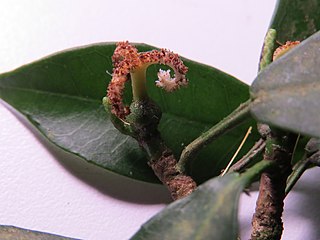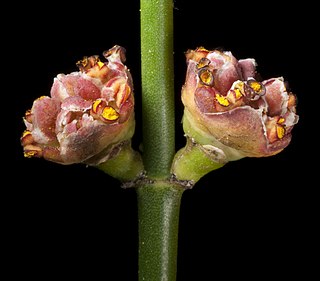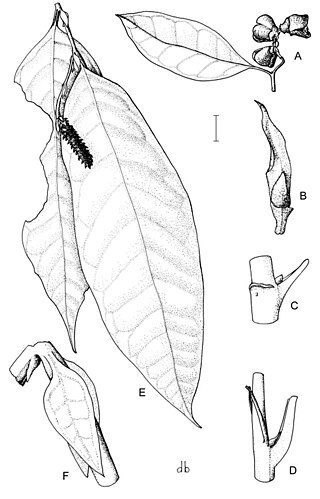Wielandia is a genus of flowering plant, of the family Phyllanthaceae first described as a genus in 1858. The plants are native to Kenya, Madagascar, and to various other islands in the Indian Ocean.
Orfilea is a plant genus of the family Euphorbiaceae first described as a genus in 1858. It is native to Madagascar and other islands in the Indian Ocean.
- Orfilea ankafinensis(Baill.) Radcl.-Sm. & Govaerts - W Madagascar
- Orfilea coriaceaBaill. - Comoros, Madagascar
- Orfilea multispicata(Baill.) G.L.Webster - Madagascar
- Orfilea neraudiana(Baill.) G.L.Webster - Mauritius
Speranskia is a plant genus of the family Euphorbiaceae first described in 1858. It is the only genus of the subtribe Speranskiinae. The entire genus is endemic to China.
- Speranskia cantonensis(Hance) Pax & K.Hoffm. - Hubei, Guangdong
- Speranskia tuberculata(Bunge) Baill. - Anhui, Gansu, Hebei, Henan, Jilin, Liaoning, Nei Mongol, Ningxia, Shaanxi, Shandong, Shanxi, Sichuan
- Speranskia yunnanensisS.M.Hwang - Yunnan

Adenochlaena is a genus of plant of the family Euphorbiaceae first described as a genus in 1858. It is native to certain islands in the Indian Ocean.
- Adenochlaena leucocephalaBaill. - Madagascar, Comoros
- Adenochlaena zeylanica(Baill.) Thwaites - Sri Lanka
Sphaerostylis is a genus of plant of the family Euphorbiaceae first described as a genus in 1858. The entire genus is endemic to Madagascar.
- Sphaerostylis perrieriLeandri
- Sphaerostylis tulasneanaBaill.
Alphandia is a plant genus of the family Euphorbiaceae first described as a genus in 1873. It is native to certain islands in the western Pacific.
- Alphandia furfuraceaBaill. - New Caledonia, Aneityum
- Alphandia resinosaBaill. - Art Island in New Caledonia
- Alphandia verniciflua Airy Shaw - West New Guinea

Blachia is a genus of plants under the family Euphorbiaceae first described as a genus in 1858. It is native to Southeast Asia, southern China, and the Indian Subcontinent.
Cocconerion is a genus of plants under the family Euphorbiaceae first described as a genus in 1873. The entire genus is endemic to New Caledonia and is related to Baloghia.
- Cocconerion balansaeBaill. - SE New Caledonia
- Cocconerion minusBaill. - New Caledonia, Loyalty Islands
Dalembertia is a plant genus of the family Euphorbiaceae first described as a genus in 1858. It is native to Mexico and Guatemala.
- Dalembertia hahnianaBaill. - México State, Morelos, Michoacán
- Dalembertia platanoidesBaill. - Oaxaca, Guerrero, México State
- Dalembertia populifoliaBaill. - from Sonora to Oaxaca
- Dalembertia triangularisMüll.Arg. - Guatemala, Chiapas, Oaxaca

Algernonia is a plant genus of the family Euphorbiaceae first described as a genus in 1858. It is native to Peru and Brazil.
Dissiliaria is a genus of plants under the family Picrodendraceae described as a genus in 1867.

Meineckia is a genus of flowering plants in the family Phyllanthaceae first described as a genus in 1858.

Henri Ernest Baillon was a French botanist and physician. He was born in Calais on 30 November 1827 and died in Paris on 19 July 1895.
Thomandersia is the sole genus in the Thomandersiaceae, an African family of flowering plants. Thomandersia is a genus of shrubs and small trees, with six species native to Central and West Africa.
Zuckertia cordata is a species of flowering plant in the family Euphorbiaceae, native from southern Mexico to Central America. It was first described by Henri Ernest Baillon in 1858.

Elaeoluma is a genus of plants in the family Sapotaceae described as a genus in 1891.

Bouchardatia is a genus of two species of tree in the family Rutaceae, one species endemic to eastern Australia, the other to New Guinea. They have compound leaves with three or five leaflets, and are arranged in opposite pairs. The flowers are bisexual, arranged in panicles, each flower with four sepals, four petals and eight stamens, the petals and stamens all free from each other. The fruit has up to four ridged follicles fused at the base, each containing a single seed.
Zygoruellia richardii is a species of flowering plant in the family Acanthaceae. It is endemic to Madagascar. The monotypic genus and species were first formally named in 1890 by French botanist Henri Ernest Baillon. It is the only species in the genus Zygoruellia.

Calycopeplus paucifolius is an erect shrub species in the family Euphorbiaceae. It is found in South Australia & Western Australia.

Ostrearia is a monotypic genus - i.e. a genus containing only one species - of plants in the witch-hazel family Hamamelidaceae. It is the first described of three monotypic Australian genera in this family, the others being Neostrearia and Noahdendron. It is most closely related to these genera, as well as Trichocladus from southern Africa and Dicoryphe from Madagascar, and together these five genera form a distinct clade within Hamamelidaceae.








